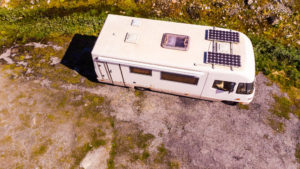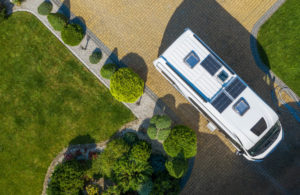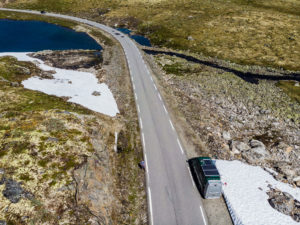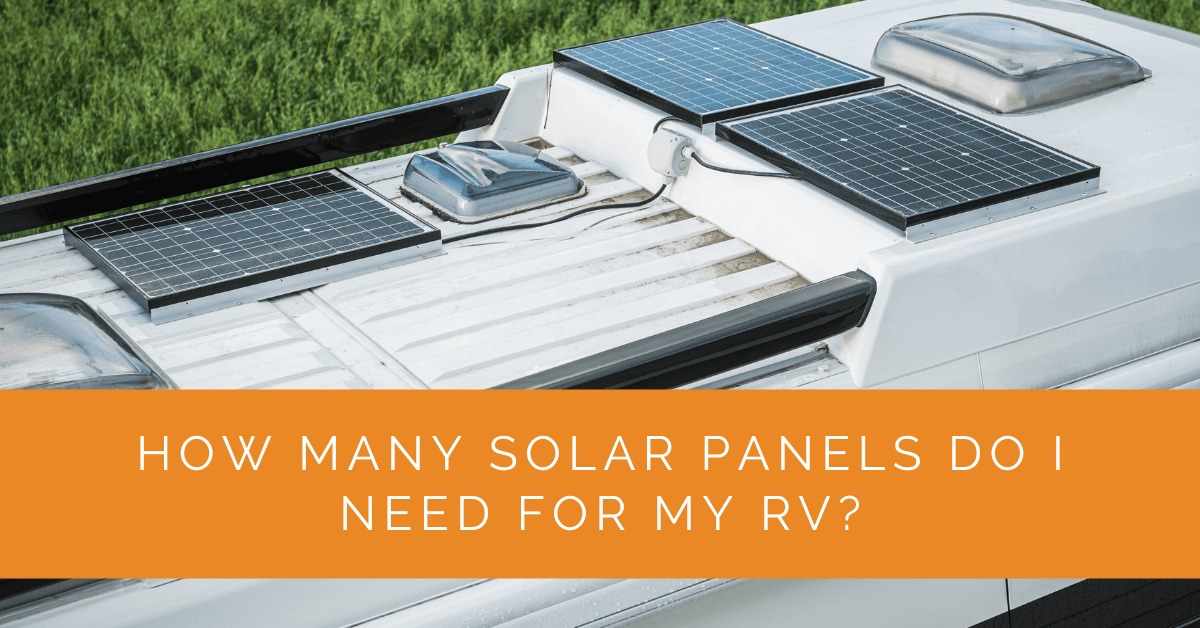Harnessing the sun’s power for your RV opens up a world of possibilities for off-grid adventures. Solar panels provide a clean, sustainable, and reliable energy source, allowing you to power your RV and enjoy the comforts of your home while exploring remote locations. However, determining the right number of solar panels and optimizing their placement can be daunting. In this comprehensive guide, we will walk you through the process of determining how many solar panels you need for your RV and how to optimize their placement for maximum energy generation. From assessing your power needs to understanding solar panel capacity, we will provide the insights and information you need to design an efficient and reliable RV solar system. Get ready to embark on your solar-powered RV journey with confidence!
Contents
- 1 Key Takeaways
- 2 Assessing Your RV Power Needs
- 3 Determining Solar Panel Capacity
- 4 Optimizing Solar Panel Placement
- 5 Case Study: Designing an Efficient Solar System for an Off-Grid RV
- 6 Expert Insights From Our Solar Panel Installers About How Many Solar Panels You Need for Your RV
- 7 Experience Solar Excellence with Us!
- 8 Conclusion
Key Takeaways
- Assess your RV’s power needs, calculate daily energy consumption, and account for efficiency and solar panel output when determining the required solar panels.
- Consider factors such as wattage, battery capacity, and available space when sizing your solar panel array to meet your energy requirements.
- Optimize solar panel placement by minimizing shading, using adjustable tilting systems, ensuring proper wiring, and allowing for easy monitoring and maintenance. Consulting with professionals is advisable for a safe and efficient installation.
Assessing Your RV Power Needs
To ensure you have an efficient and reliable RV solar system, it’s crucial to assess your power needs accurately. Let’s break down the process into more detail:
Understanding Your RV’s Energy Consumption
Begin by creating a comprehensive list of all the appliances and devices in your RV that require power. This can include lighting fixtures, refrigerators, water pumps, entertainment systems, air conditioning, heating, and any other electrical devices you typically use during your travels.
Once you have your list, note down the wattage rating for each appliance. This information is usually available on the appliance or user manual. If you can’t find the wattage, you may be able to determine it by checking the voltage and current rating and using the formula: Power (in watts) = Voltage (in volts) × Current (in amperes).
Calculating Daily Energy Consumption
To determine your daily energy consumption, multiply each appliance’s wattage by the hours you typically use them daily. This will give you the energy each appliance consumes daily in watt-hours (Wh). Add up the individual energy consumption values to obtain your RV’s total daily energy consumption.
For example, let’s say your refrigerator uses 100 watts and runs for an average of 8 hours per day. The refrigerator’s energy consumption would be 100 watts × 8 hours = 800 watt-hours (or 0.8 kilowatt-hours) per day. Repeat this calculation for each appliance and summarize the results to find the total daily energy consumption.
Accounting for Efficiency and Solar Panel Output
While calculating your energy consumption, it’s crucial to consider the efficiency of your solar panels and the overall output of your solar system. Solar panel efficiency refers to how effectively the panels convert sunlight into electricity. Higher-efficiency panels produce more power for the same surface area.
Additionally, weather conditions and sunlight availability can impact the output of your solar panels. Regions with abundant sunshine will generate more energy than those with frequent cloud cover. Consider these factors when calculating the number of solar panels needed to meet your energy requirements, ensuring you account for any variations in sunlight conditions.
By taking into account the efficiency of your panels and the potential output based on weather conditions, you can more accurately determine the number of solar panels required to power your RV efficiently and effectively.
Remember, it’s always recommended to slightly oversize your solar system to accommodate energy losses and ensure you have enough power during periods of low sunlight or high energy demand.
With a thorough assessment of your power needs, you can confidently move forward, knowing you are on the right track to designing a solar system that suits your RV’s requirements.

Determining Solar Panel Capacity
Several factors must be considered when determining the capacity of solar panels for your RV. Let’s delve into each subheading to help you make an informed decision:
Solar Panel Wattage and Voltage
Solar panels are available in various wattage and voltage options. The wattage of a solar panel indicates the power it can generate under standard test conditions. Higher-wattage panels produce more electricity but are larger and require more space on your RV’s roof.
Consider the available roof space on your RV and your power requirements when choosing the wattage of your solar panels. If you have limited roof space, you may need to opt for lower-wattage panels that still meet your energy needs. Conversely, if you have ample roof space, you can install higher-wattage panels to generate more power.
It’s also important to ensure the voltage of the solar panels matches the charging requirements of your battery bank and charge controller. Most RV solar systems operate at 12 volts or 24 volts. Check the specifications of your battery bank and charge controller to determine the appropriate voltage range for your solar panels.
Considering Battery Capacity
A crucial component of your RV solar system is the battery bank. The battery bank stores the excess energy generated by the solar panels for later use, ensuring a steady power supply during periods of low sunlight or at night.
To determine the battery capacity needed, consider the energy you require during these low-sunlight periods. Calculate your RV’s total energy consumption per day, considering the watt-hours (Wh) calculated in the “Assessing Your Power Needs” section.
It’s important to note that deep-cycle batteries, such as lithium batteries, are commonly used in RV solar systems due to their efficiency and ability to handle multiple charge and discharge cycles. They provide reliable power storage and are well-suited for off-grid applications.
By accurately assessing your energy consumption and understanding your battery bank’s capacity, you can ensure enough stored energy to meet your RV’s power needs, even when the sun isn’t shining.
Sizing Your Solar Array
Now that you have determined your daily energy consumption and battery capacity, it’s time to size your solar array accordingly. The solar array refers to the total capacity of the solar panels you will install on your RV.
To calculate the number of solar panels needed, divide your daily energy consumption (in watt-hours) by the wattage of a single solar panel. For example, if your daily energy consumption is 3000 watt-hours and you have 100-watt solar panels, the calculation would be:
Number of solar panels = Daily energy consumption (in watt-hours) / Wattage of a single solar panel
Number of solar panels = 3000 watt-hours / 100 watts
Number of solar panels = 30 panels
In this example, you would need approximately 30 solar panels to meet your energy requirements.
However, it’s important to consider other factors that can affect your solar panel performance. These factors include system losses due to wiring, charge controller inefficiencies, and shading. To account for these losses, it’s recommended to slightly oversize your solar array.
Not all panels may fit on your RV’s roof due to space limitations or other obstructions. Consider the available roof area and plan your panel placement accordingly.
By accurately sizing your solar array, you can ensure enough solar panel capacity to generate sufficient power and charge your battery bank effectively, allowing for a reliable and sustainable power source for your RV.
Determining your RV’s solar panel capacity involves carefully considering wattage, battery capacity, available space, and other system factors. Take the time to analyze these aspects to design an optimized RV solar system that meets your power requirements effectively and maximizes energy generation. Here are a few additional factors to consider:

Charge Controller and System Compatibility
A charge controller is a crucial component of your RV solar system as it regulates the charging process, preventing overcharging and optimizing battery performance. When determining solar panel capacity, ensure that your charge controller can handle the combined wattage of the panels you plan to install.
Check the specifications of your charge controller to determine its maximum input wattage or current rating. This will help you ensure that your solar panel capacity aligns with the capabilities of your charge controller, ensuring compatibility and efficient operation of your system.
Considering Solar Energy Expansion
While determining your RV’s initial solar panel capacity is worth considering the possibility of future expansion. If you anticipate increased energy consumption or plan to add more electrical devices to your RV, accounting for potential expansion can save you from the hassle of retrofitting or upgrading your system later on.
By leaving room for future expansion, such as reserving additional roof space or installing an oversized charge controller, you can easily integrate more solar panels into your system as your needs evolve.
Seeking Professional Guidance
Designing and installing an RV solar system can be complex, especially if you’re new to solar power. Consulting with a professional solar installer or RV solar specialist is highly recommended if you’re unsure about the calculations, wiring, or overall setup.
They have the expertise to assess your specific RV setup, analyze your energy requirements, and provide tailored recommendations. They can also guide you in selecting the right solar panels, batteries, charge controllers, and other necessary components to ensure a safe, efficient, and reliable solar system for your RV.
Maintenance and Monitoring
Once your RV solar system is installed, it’s important to establish a routine maintenance schedule and monitor its performance. Regularly inspect the solar panels for any signs of damage or debris that may affect their efficiency. Clean the panels periodically to remove dust, dirt, or any obstructions that might hinder sunlight absorption.
Monitor the charging levels of your battery bank and keep track of energy generation to ensure your system is operating optimally. If you notice any significant drops in performance or suspect issues with your system, contact a professional to diagnose and address the problem promptly.
Remember, proper maintenance and monitoring are crucial to maximizing the lifespan and performance of your RV solar system, allowing you to enjoy clean, sustainable power on your adventures.
Considering all these factors and seeking expert guidance, you can confidently determine the solar panel capacity required for your RV and design a robust solar system that reliably meets your power needs.

Optimizing Solar Panel Placement
The optimal placement of your solar panels plays a crucial role in maximizing their energy generation. Consider the following factors when determining the placement of your RV solar panels:
Considering the RV’s Roof Space
Begin by assessing the available roof space on your RV. Take measurements and note any obstructions, such as air conditioning units, vents, or antennas, that might limit the available area for solar panels. Consider the orientation and shape of your roof as well.
Remember that solar panels are typically installed in a rectangular shape, so it’s essential to find a suitable area with minimal obstructions that can accommodate the size and number of panels you need.
Accounting for Shading and Obstacles
Shading can significantly impact the performance of your solar panels, even partial shading from nearby objects like trees or buildings. Before installing your panels, evaluate the surrounding environment and identify potential shading sources throughout the day.
Position your solar panels in areas that receive the maximum sunlight exposure. Avoid areas where shadows are cast frequently, especially during peak sunlight hours. By minimizing shading, you can optimize the overall energy generation of your solar system.
If shading is unavoidable, consider using shading analysis tools or apps that can help you determine the optimal placement of your panels to mitigate the impact of shading.
Tilting and Tracking Systems
Adjustable tilting systems allow you to angle your solar panels for optimal sunlight absorption throughout the day and the seasons. Tilting the panels to match the sun’s position can significantly enhance energy generation.
Consider using tilt-mounting brackets that enable you to adjust the tilt angle of the panels manually, or opt for automated tracking systems that track the sun’s movement throughout the day. These systems can maximize your solar panel efficiency by keeping them at an ideal angle to capture the most sunlight.
While adjustable tilting and tracking systems offer benefits, they also add complexity and cost to your solar installation. Evaluate your specific needs, budget, and available roof space to determine if these features are worthwhile for your RV solar system.
Wiring and Connections
Ensure proper wiring and connections between the solar panels, charge controller, and battery bank during placement. Use appropriate wire gauges and connectors that can handle the current and voltage of your system. Follow the manufacturer’s guidelines and consult with professionals to ensure safe and efficient wiring practices.
Securely fasten the panels to the roof using appropriate mounting hardware to withstand vibrations and movements during travel. Consider using sealants or waterproofing materials to prevent water leakage and ensure the longevity of your installation.
Monitoring and Maintenance Accessibility
When finalizing the placement of your solar panels, consider accessibility for monitoring and maintenance purposes. Leave enough space around the panels for easy inspection, cleaning, and maintenance when required. This ensures that you can regularly check the condition of the panels, clean them from dirt or debris, and perform any necessary maintenance tasks to keep your system in optimal condition.
Regularly monitoring the performance of your solar panels and checking for any issues will help you identify and address problems promptly, ensuring the continued efficiency and longevity of your RV solar system.
By carefully considering the roof space, shading, tilt options, wiring, and maintenance accessibility, you can optimize the placement of your solar panels to maximize their energy generation potential and ensure the long-term effectiveness of your RV solar system.
If you’re unsure about the installation process or need assistance, consult with professionals or experienced RV solar installers to ensure your solar panels’ safe and efficient placement.
Case Study: Designing an Efficient Solar System for an Off-Grid RV
Background
Solar Panels Network USA recently helped a client design and install a solar power system for their RV to enable off-grid adventures. The client wanted a reliable and sustainable energy source to power their appliances and devices while exploring remote locations.
Project Overview
The objective was to determine the number of solar panels needed for the client’s RV, optimize their placement, and ensure efficient energy storage and usage. The project involved a thorough assessment of the client’s power needs, careful selection of solar panels, and strategic placement on the RV’s roof.
Implementation
Step 1: Assessing Power Needs
Conducted a comprehensive analysis of the client’s energy consumption by listing all appliances and devices. Calculated the total daily energy usage in watt-hours (Wh) by multiplying the wattage of each appliance by the hours of usage per day.
Step 2: Determining Solar Panel Capacity
Selected high-efficiency solar panels with appropriate wattage to meet the client’s energy requirements. Calculated the number of panels needed by dividing the total daily energy consumption by the wattage of a single panel. Ensured the panels’ voltage matched the battery bank and charge controller specifications.
Step 3: Optimizing Solar Panel Placement
Assessed the available roof space on the RV and identified potential shading sources. Positioned the panels to receive maximum sunlight exposure throughout the day, minimizing shading impact. Considered adjustable tilting systems to enhance sunlight absorption and energy generation.
Step 4: Battery Capacity and Configuration
Determined the required battery capacity to store excess energy generated by the solar panels. Chose deep-cycle lithium batteries for their efficiency, longevity, and ability to handle multiple charge and discharge cycles. Configured the battery bank to match the RV’s power needs and ensure reliable energy storage.
Step 5: Wiring and Connections
Ensured proper wiring and secure connections between the solar panels, charge controller, and battery bank. Used appropriate wire gauges and connectors to handle the current and voltage of the system.
Step 6: Monitoring and Maintenance
Implemented a monitoring system to track energy generation and battery levels. Established a maintenance schedule to regularly inspect and clean the solar panels, ensuring optimal performance.
Results
The optimized solar system successfully met the client’s energy needs, providing reliable power for their RV during off-grid adventures. The system’s performance exceeded expectations, allowing the client to enjoy extended stays in remote locations without relying on traditional power sources. The client reported significant energy savings and appreciated the system’s low maintenance requirements.
Summary
This project highlights the importance of accurately assessing power needs, selecting the right solar panel capacity, and optimizing panel placement for an efficient RV solar system. Solar Panels Network USA delivered a reliable and sustainable energy solution for the client’s off-grid RV, ensuring they could explore remote locations with confidence.
Expert Insights From Our Solar Panel Installers About How Many Solar Panels You Need for Your RV
Accurately assessing your RV’s power needs is crucial for designing an efficient solar system. By understanding your daily energy consumption, you can make informed decisions about the number of panels required.
Senior Solar Installer
Choosing the right wattage and battery capacity is essential for optimizing your RV’s solar setup. Ensure that the panels’ voltage matches your battery bank and charge controller for seamless operation.
Lead Solar Technician
Proper placement of solar panels on your RV is key to maximizing energy generation. Minimize shading, consider tilting systems, and ensure secure wiring for optimal performance.
Solar Installation Manager
Experience Solar Excellence with Us!
Trust in Solar Panels Network USA, where our seasoned experts deliver top-quality solar solutions for homes and businesses nationwide. With a legacy of countless successful installations and a commitment to sustainable energy, we’re your reliable partner in the solar journey. Ready for a brighter, eco-friendly future? Call us now at (855) 427-0058 and harness the sun’s power!
Conclusion
Properly sizing your solar panel setup is essential for powering your RV with solar energy. By understanding your energy consumption, calculating panel capacity, and optimizing placement, you can create an efficient and reliable off-grid power source for your adventures. Remember to consider factors such as wattage, battery capacity, panel placement, and shading to maximize the performance of your RV solar system.
With the increasing popularity of solar power among RVers, many resources and online calculators are available to help you determine the number of solar panels you need for your specific RV and power requirements. Additionally, consulting with solar experts or professional installers can provide valuable insights and ensure a successful solar installation.
Harnessing the power of the sun not only reduces your reliance on traditional power sources but allows for a more sustainable and eco-friendly RV experience. Take the time to plan and calculate your energy needs accurately, and soon, you’ll be enjoying the freedom of off-grid living with your well-powered RV solar system.
Remember, when embarking on a solar installation, prioritize safety and consult with professionals as needed. Happy RVing with your solar-powered adventures!
About the Author
Solar Panels Network USA stands at the forefront of solar energy solutions, driven by a team of seasoned solar engineers and energy consultants. With over decades of experience in delivering high-quality solar installations and maintenance, we are committed to promoting sustainable energy through customer-centric, tailored solutions. Our articles reflect this commitment, crafted collaboratively by experts to provide accurate, up-to-date insights into solar technology, ensuring our readers are well-informed and empowered in their solar energy decisions.

